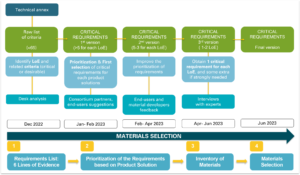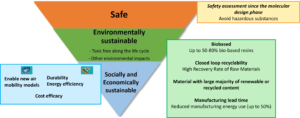Design requirements for performance, sustainability and safety: REPOXYBLE’s compilation
REPOXYBLE completed the compilation of design requirements for performance, sustainability and safety to inform the development of materials and product solutions of the project. The aim has been to select the building blocks leading to the epoxy resin system, and identifying criteria to pursue a Safe and Sustainable by Design (SSbD) approach since the very early stages of the material development.
The definition of design requirements helps to:
- Identify, select, and describe a set of critical criteria, relevant from the point of view of end-users within the consortium. This work will be instrumental to ensure that the product solutions developed in REPOXYBLE will follow SSbD principles, as outlined by the European framework.
- Provide an initial set of requirements that could be updated and used as reference throughout the whole project workflow, contributing to build up the iterative dimension of the SSbD approach.
- Collect information about the material development process and the whole life cycle, to understand the future impacts of the product solutions that are going to be developed.
- Inform the selection of materials to be used to develop the two product solutions for the aerospace and automotive case studies, and the product solution dedicated to Depolymerizable Closed Loop Epoxy system (DCLE).
The design requirement (criteria) identification and selection in REPOXYBLE has been an iterative process based on a stepwise approach (fig. 1), going through five different phases. It took advantage of (i) desk analysis, based on the project technical annex and literature, (ii) partners’ expertise and bilateral meetings with the whole consortium, end-users and materials developers, and (iii) interviews with external stakeholders, to validate the selected requirements.

Figure 1: The REPOXYBLE stepwise approach towards design requirement identification and criteria selection. The material selection process evolved over time together with the design criteria selection.
Requirements selection has been done along six dimensions (Lines of Evidence), respectively: Performance (structural, functional), Technological (highly reproducible process, lead time, energy efficiency), Safety (avoid substances of concern), Sustainability (raw materials selection, bio-based composition, renewable & recycled content, closed loop, waste management), Legal (chemical regulation, end-users standards for aerospace and automotive sectors), Economic (costs and cost efficacy). Both desirable and critical criteria were identified for each LoE, and for each criterion a range of acceptable and optimal target values have been set, based on the benchmarks available on the market, and the ambitions of our project.
Critical criteria have been considered and evaluated following the hierarchical approach set in the SSbD framework of the European Commission, where safety is the starting point to address the sustainability of the product (Figure 2).

Figure 2: SSbD Design requirements: Highlights from REPOXYBLE. Ref. Safe and Sustainable by Design chemicals and materials Framework for the definition of criteria and evaluation procedure for chemicals and material.
Notably, criteria and related target values have been identified based on the specific target product solutions, and the product life-phase considered as well (Raw Materials, Manufacturing, Use, End of Life).
All the information related to the materials and the requirements have been collected and organized in comparison matrices; then a multi-criteria decision analysis (MCDA) methodology allowed to compare, assess, and eventually select the raw materials initially identified against the different requirements. Whit our work, we successfully proposed an initial list of definitions and criteria related to the building blocks for epoxy resin systems, components, formulated composite systems, and product solutions, and defined as well indicative criteria to address the next steps of the project.

Figure 3: The different phases of the material development, from the resin to the final composite.
The added value of the SSbD approach lies in its iterative dimension, because its implementation brings in-depth knowledge on the whole life cycle of the material, and the more knowledge you get, the better you can design and optimize your product solutions, in terms of both performances and sustainability. SSbD needs to be implemented since the very early stages of the material workflow to collect information on risk and impact dimensions, potential hotspots, process, use and End of Life issues, that could then be refined along the overall development process.

